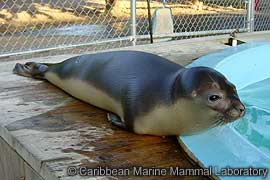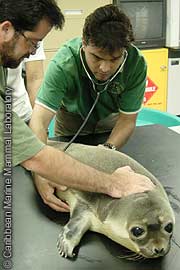The Caribbean or West Indian monk seal (Monachus tropicalis) lived in the waters of the Gulf of Mexico, Florida, Bahamas and Caribbean Sea up until the middle part of the last century. The last confirmed sighting of a Caribbean monk seal was in 1952 and several surveys in the 1970s and 1980s indicated that the species was extinct. However, even as recently as the late 1990s, researchers were still looking for evidence that this extinction was a myth and that Caribbean monk seals still roamed these tropical waters.
Unconfirmed sightings of pinnipeds in the tropics of the Western North Atlantic have fed the hope of finding individual monk seals still alive there. So is the Caribbean monk seal really extinct?
 |
|
|
|
Hooded seal in rehab at the Caribbean Stranding Network facility in Puerto Rico
|
|
|
In 1993 and 1996, two hooded seals (Cystophora cristata) stranded in Puerto Rico and the Virgin Islands respectively, suggesting that previously unconfirmed sightings might have been stray arctic seals, even as far-fetched as this long-distance travelling may seem. Well, these anomalous findings have not stopped since. Marine mammal conservation and rehabilitation organizations have been astounded at the large number of hooded seals that have so far stranded or been sighted down both the western and eastern coasts of the North Atlantic.
A species of the far north, hooded seals are distributed from Svalbard in the east to the Gulf of St. Lawrence in the west, giving birth in the spring on the drifting heavy pack ice in four main concentrations: near Jan Mayen Island (between Norway, Iceland and Greenland), off Labrador and northeastern Newfoundland, in the Gulf of St. Lawrence, and in the Davis Strait (between Canada and Greenland).
Hooded seal juveniles in particular have been known to wander fairly large distances off the beaten track, and individuals have been found far south in previous years. However, never before to the extent witnessed this year. By the end of October more than 100 individuals, either dead or live stranded, had been reported from as far south as the Caribbean island of Antigua in the west and the Canary Islands in the east. A third of these were reported in or after June. Individuals of the species have been reported from the eastern seaboard of the United States (from Maine to North Carolina), Bermuda, Bahamas, Turks and Caicos Islands, Puerto Rico, Anguilla, St. Barthélémy, the United Kingdom, Ireland, Germany, Denmark, France, Spain and Portugal.
|
 |
|
|
A hooded seal stranding victim undergoing veterinary examination
|
|
The reasons for these hooded seal wanderings are currently unknown, but an increasing number of strandings and sightings have been reported in the past six years. The Caribbean Marine Mammal Laboratory at the Universidad Metropolitana in Puerto Rico, and the Seal Conservation Society in the United Kingdom are coordinating, in participation with government organizations, research establishments and rescue and rehabilitation organizations, the collection and analysis of stranding data and samples in order to attempt to determine the cause of this anomaly. Among the factors that are being examined are annual stranding patterns and the pathological condition, toxicology and virology of each seal.
The hooded seals being found are mostly emaciated and dehydrated, many suffering from heat exhaustion, and are in need of immediate medical assistance to secure their survival. A number of the seals are still in rehabilitation on both sides of the North Atlantic, including one at the Caribbean Stranding Network rehabilitation facility in Puerto Rico. The Laboratory is hoping, in conjunction with colleagues in North America and Europe, to tag or satellite track a number of the rehabilitated seals when they are released as the information gained from such tracking may shed some light on the reasons for this unusual event.
Back to the initial question – is the Caribbean monk seal extinct? It certainly is. It is easily within the bounds of possibility that previous reports of “Caribbean monk seals” have, in fact, been of occasional stray hooded seals. Confirmed reports of seals in the tropical western Atlantic in recent years have all been of hooded seals, whereas there has been no evidence of Caribbean monk seals in the region during the past 50 years. It appears that the hooded seals are increasingly straying far into new territories, even those a long distance away from their home in the far north, and are visiting the tropical beaches previously enjoyed by the sadly demised Caribbean monk seal.

